R.A.F. HOOTON, IMAGES FROM THE 1950s.
Some years ago in an earlier post on this thread I noted the apparent lack of published photos taken at RAF Hooton during the R.Aux.A.F., post war years. Apart from the 611 Squadron history ('Beware, Beware', Aldon Ferguson & John Hamlin, Airfield Publications 2004) there are few images of the Spitfires, and the Meteors at Hooton around - indeed there are not even that many in Aldon’s book! Finally, thanks to Don Stephens keeping his photo collection intact and his daughter for passing boxes of photos on to someone who appreciates their value as images of times past, I am able to redress the paucity of published photos for this period at Hooton.
I’m delighted that, as I have sifted through the Don Stephens collection of photographs, typed onto searchable spreadsheet his index, added more details from the images and scanned further loose images to expand on those earlier scanned by Graham Ward, I kept on coming across familiar squadron markings. While there could be a few further images not yet identified as connected with Hooton, I’m now very happy to bring to NWAN Forum a photo thread with around 40 images at RAF Hooton, or aircraft connected with Hooton units during the mid ‘Fifties. They are not all the work of Don’s own camera, some are clearly acquired at the time from his contemporary enthusiasts, but very few are labled with the actual photographer’s name! Certainly his group of photograph contributors included Phil Butler, Alan Scholefield and Peter Whalley.
So sit back and scroll through this collection of RAF Hooton images from the mid ‘50s. Those around at time can wallow in nostalgia, those (like me) in primary school at time can reflect on what they had just missed, while generations since can simply absorb the ‘50s feel, a time now fading towards history when Britain had a large air force and a large pool of former military pilots willing to keep flying at the weekends should they ever be required to defend their country again, this reserve force being organised as the Royal Auxiliary Air Force.
THE RESIDENT ROYAL AUXILARY AIR FORCE METEOR UNITS.
No.610 ‘County of Cheshire’ Squadron Meteors had a fuselage insignia bar either side of the roundel in black and white, a ‘curved teeth’ like design abstracted from a section of their unit badge which featured a sheaf of wheat. While, No.611 ‘West Lancashire’ Squadron featured a bar of small triangles forming diamonds in yellow, red and black. Both Units re-equipped at Hooton from Spitfires in mid-1951 with Meteor F.4s and T.7s in all-over silver. The Meteor F.4s were not in use for long, being replaced by the superior Mk. F.8s in Spring 1952, with the T.7s being retained in service. The F.8s were initially in ‘silver’ - bare polished metal, but were all camouflaged in early 1954, although the T.7s retained their silver scheme throughout. All flying by the Auxiliary Air Force ceased in January 1957 and the units disbanded in March 1957. RAF Hooton became surplus to requirements and subsequently the site for a new Vauxhall Motor factory constructed in the early 1960s.

A charming shot of WH505/A 611 Sqdn in plain metal outside the (now) historic WWI hangars at RAF Hooton. Photo undated, but has to be between Spring ’52 and early ’54 – note the air raid siren mounted on the hangar roof. Two further shots of this aircraft in camouflage follow shortly. Subsequently find that this image is elsewhere on the internet as a copyrighted Alan Scholefield photo, dated 20th September 1952. Interestingly Don has two prints of this image, both have identical marks on the doors which are not there on the RAS internet image. Question is, are the marks WWII Luftwaffe damage or are they the result of contamination in the printing process? Answer appears to probably be the later, contamination during the printing process.

Plain metal Meteor F.8 WK852/C 611 Squadron on the taxiway 30th August 1953,

An uncoded Meteor F.8 WK988 in 610 Sqdn marks while in plain metal. There is another shot of this aircraft further down in camouflage scheme marked as the Squadron Commander’s aircraft.

A glorious flight-line view of the RAF Hooton apron on 18th June 1953 with 9 neatly parked Meteors of 610 Sqdn. The line-up features 7 x F.8s and 2 x T.7s, with WH386/P at the near end, then codes /F and /E. Both WH383/E and WH384/F were lost 5 months later, on 14th November 1953 when they flew into a hillside while in cloud at Edgeworth, Lancs. Sadly both pilots, F/O Mercer and F/O Fletcher perished in the crashes.

A formation of 16 x Meteor F.8s and likely T.7s too, almost certainly at a Hooton Battle of Britain display in 1953 or 1954. Cannot be the final Battle of Britain display in 1956 as the based squadrons formation was composed of fewer aircraft, while in 1952 they put up a formation of 20 aircraft.
The peace-time air superiority silver made way for camouflaged uppers in early 1954, the units’ distinctive roundel bars remaining the same.

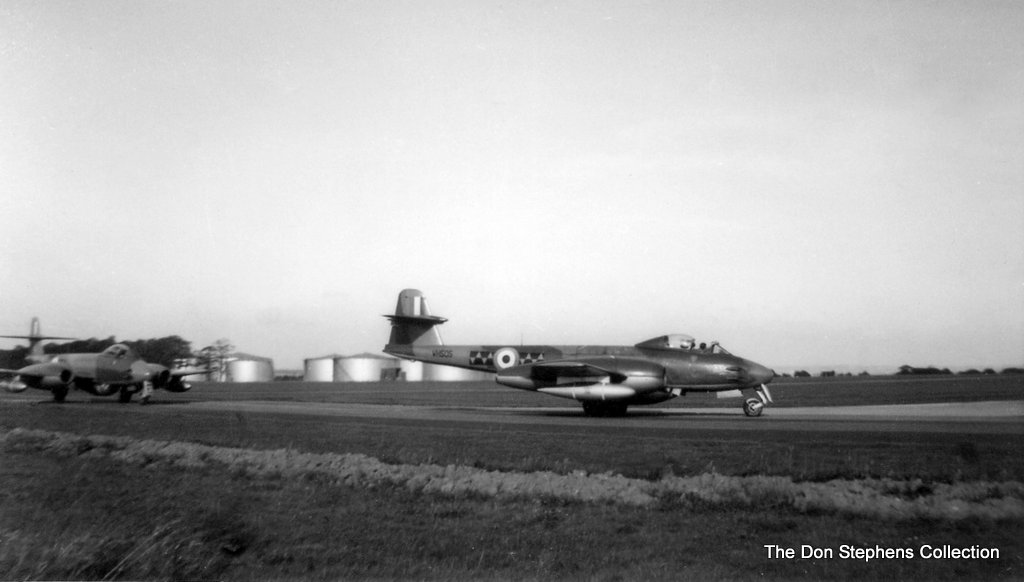
Two shots of WH505/- with 611 Sqdn, both clearly on the same occasion, 28th August 1954. As can be seen on an earlier photo, WH505 normally carried the individual code ‘A’, but a few months after re-spray has yet to be reapplied.

An uncoded, unidentifiable aircraft of 611 Squadron, taken on the same day as the two images above. However is a different aircraft as it does not have under-wing tanks fitted and a totally clear 'tear-drop' canopy.

This undated photo is not quite as straightforward as it initially seems. Clearly a Meteor F.8 with the taller, straight leading-edge upper fin, but the serial VH365/D is way too early for an F.8 (main production commenced with VZ••• serials). As it is known that
WH365 was an F.8, coded D in service with 611 Squadron it appears that, possibly for a special event, it was ‘disguised’ as a F.4 with part of the canopy obscured and the serial amended in order to play the part of an earlier aircraft - or perhaps just a paint shop error that took a while to correct? I’ve also come across a flying shot of ‘VH365’ used by James J Halley in an Air Britain RAF Unit History book, but without editorial comment.

WK988 Meteor F.8, the fin colours show this aircraft to be the mount of the No.610 Squadron Commander. Image dated as ‘during 1956’. There is an earlier shot higher up of this aircraft while in plain metal finish.
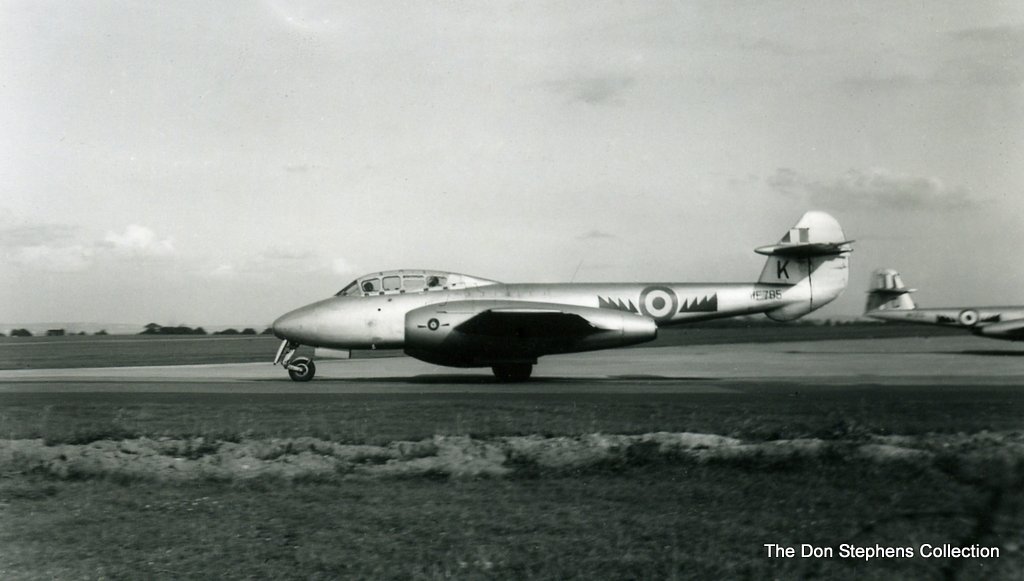
Meteor T.7 WF785/K of 610 Sqdn on 28th August 1954
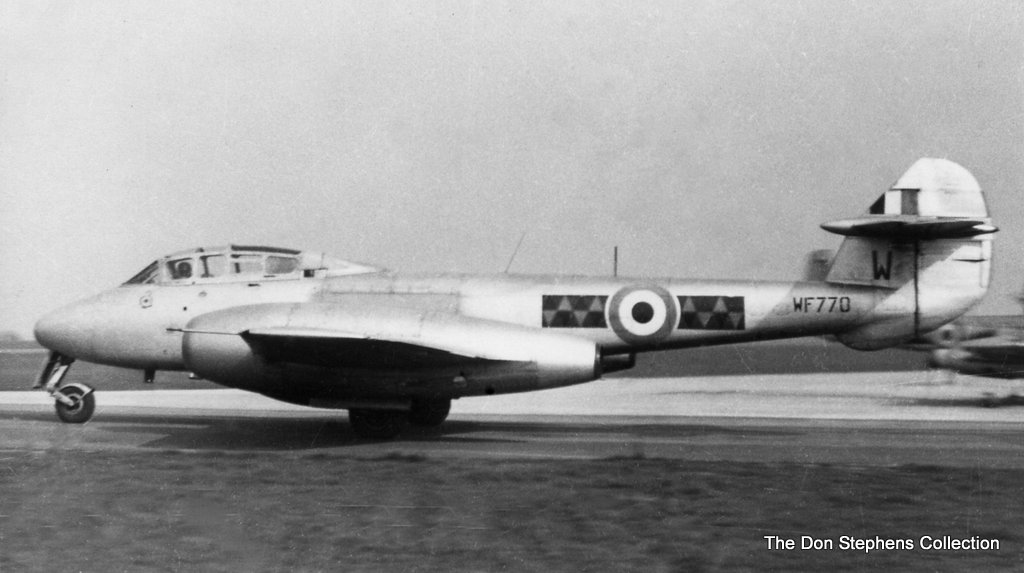

An undated shot of Meteor T.7 WF770/W of 611 Sqdn. True one is a dark-room enlargement of the other, but I cannot decide if the cropped or the wider view makes the best image! In general terms, while digitally cleaning all these images, when I crop any images I leave the full width, just taking out excess sky or foreground.
FOLLOWING DISBANDMENT OF THE ROYAL AUXILIARY A.F. SQUADRONS
The majority of the Meteor F.8s, although still very much in an airworthy state were flown to No.12 MU at RAF Kirkbride initially for storage, but most then scrapped, or in modern parlance ‘reduced to spares’. A few were exported, some converted to drones as Meteor U.16s, while others became station fire department training aircraft. At least one ‘escaped’ (WF643/F 611 Sqdn) and survives to this day with the Norfolk & Suffolk Air Museum at Flixton. This next set show the final days of some former 610 and 611 Squadron aircraft.

On the far left is •••••/H of 610 Sqdn, RAF Kirkbride on 1st April 1959.

Meteor F.8 WA929/L of 611 Sqdn at RAF Kirkbride on 1st April 1959, along with WF678/- and WA776/S of 610 Sqdn.
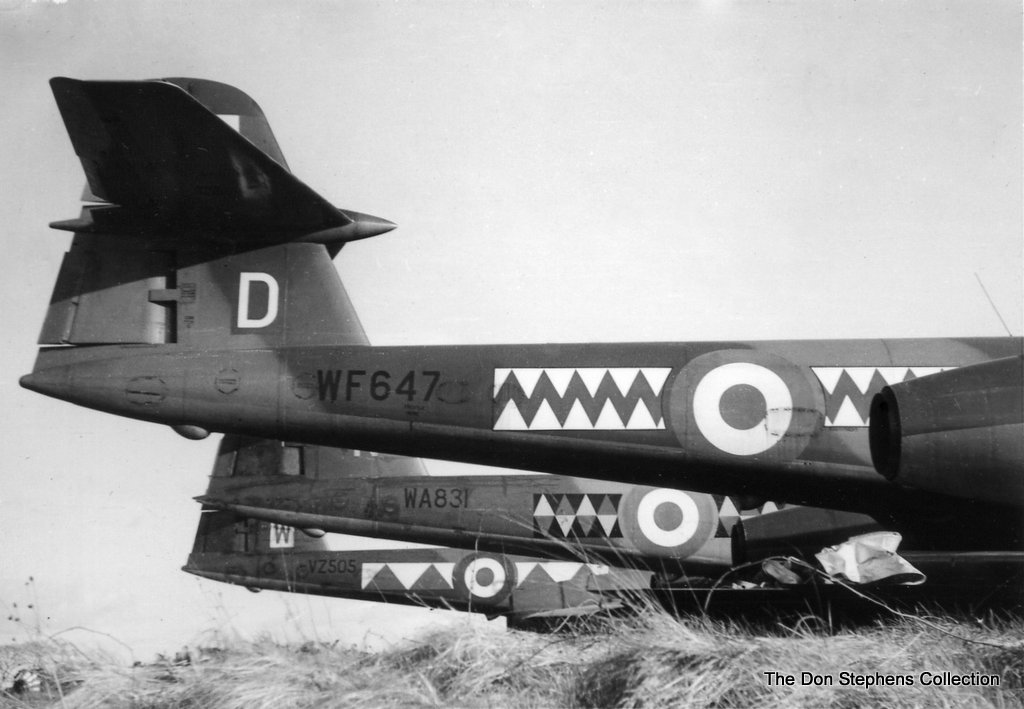
WF647/D formerly with 615 Sqdn, WA831/N with the 611 Sqdn colours showing very clearly and VZ505/W ex 600 Sqdn. Also RAF Kirkbride, 1st April 1959.

Meteor F.8 •••••/P formerly with 610 Sqdn over on the left. The aircraft in the foreground is a former 500 Sqdn RAuxAF aircraft. The silver trio over in the background on the right have the shorter, rounded topped fin of the earlier Mk. F.4. RAF Kirkbride, date not recorded.

WK988 Meteor F.8 suffering the lingering fate of being a fire-practice airframe at RAF Tern Hill. This aircraft appears in two photos above, first as a silver aircraft, then marked as the CO’s aircraft in camouflage, and now plain metal once again. The date unknown, but it survived into the early 1960s.
AERO & ENGINEERING (MERSEYSIDE) LTD
In 1955 with the departure of Martin Hearn, the Hooton based aviation engineering company changed name. They were contracted to repaint 141 Royal Canadian Air Force (RCAF) F-86 Sabres from silver finish to camouflage uppers, the aircraft starting to arrive in February 1955 and the final aircraft leaving in 1956, with the company ceasing trading shortly afterwards. Concurrent with the F-86 Sabre work, Aero & Engineering undertook the repair and servicing of 10 RCAF CL.30 Silver Stars (Lockheed T-33ANs). They used two former No.7 AAU (Aircraft Acceptance Unit) Bellman hangars in the SE corner of the airfield for this work. These hangars were later demolished in the early '60s as construction of the Vauxhall plant commenced.

RCAF 23038 coded TF-038 a Sabre 5, image dated 4th September 1955. I've found this photo used in 'Rapide' magazine, no.11 where it is credited to Phil Butler. The caption noted that it arrived bare metal and departed in the new standard '2nd TAF' camouflage scheme. 'TF' was the unit code for 422 "Tomahawk" Squadron. The Squadron's motif would be re-applied after return to Baden-Söllingen in Germany. 23038 was later passed to 441 Squadron and eventually scrapped at Prestwick in 1960

RCAF 23054 coded BH-054, image undated and assumed to be at Hooton. This aircraft was noted at Hooton on 19th March 1955. BH is the unit code for 430 "Silver Falcon" Squadron, based at Grostenquin.

RCAF 23198 coded AX-198, image simply dated 1955. AX is the unit code for 421 Sqdn based at Grostenquin and was noted at Hooton 12th March 1955. It was later returned to Canada and became N5591S as a pilotless drone, a QF-86E with Flight Systems Inc until cancelled from the US Register 6.83.

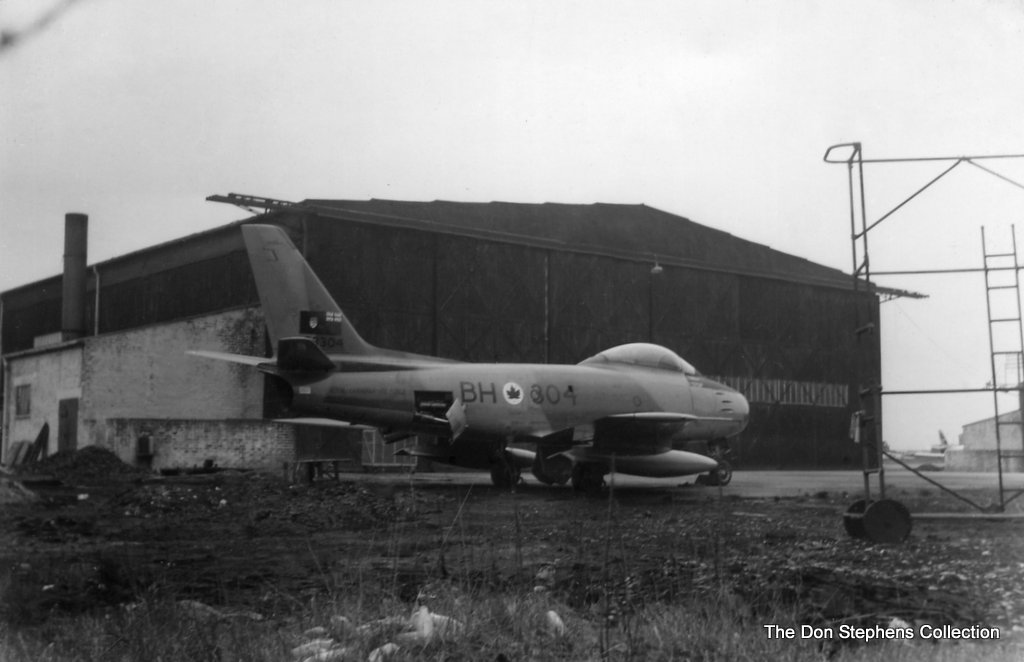
Two images of RCAF 23304 coded BH-304 images dated 27th March 1955, a Phil Butler photos. This aircraft was later returned to Canada and survived until it crashed at Chantham with the Sabre Transition Unit, 27th July 1967.
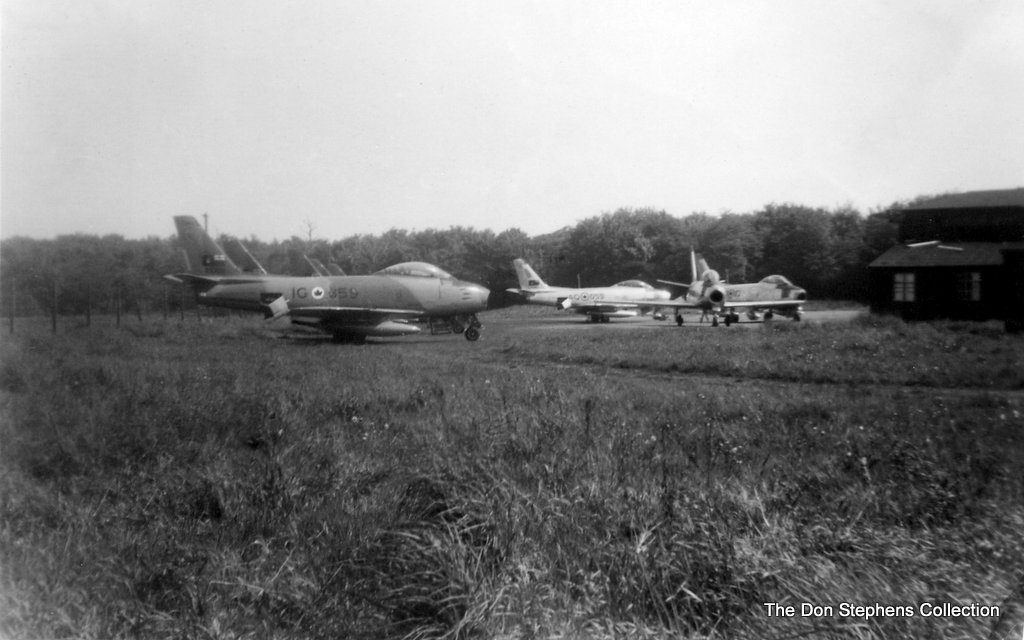
RCAF 23359 unit code IG-359 on 17th September 1955. IG was the unit code for 439 Sqdn at Marville, France. The aircraft was later returned to Canada and perished when it hit trees recovering from a loop at Chatham 12th March 1959. Almost certainly a Phil Butler photo.
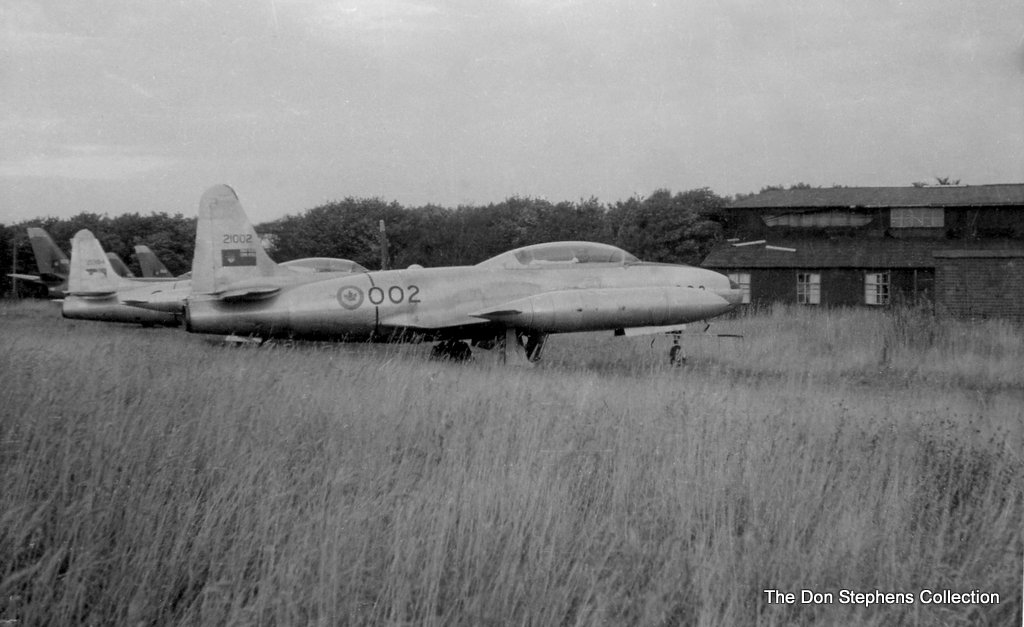
Sole image in the collection of CL-30s (T-33ANs) at Hooton, in the foreground 21002 with code 002 and 21384 beyond. Undated, but clearly the same day as the photo of Sabre IG-359, so 17th September 1955. I've seen this image in print in a c.2006 issue of 'Rapide' magazine credited to Phil Butler, so the Sabre photo above his too. An Alan Scholefield article in Rapide states that after service with the RCAF that aircraft 21002 went to the French Air Force, unit coded '314-UK'.
No.663 SQUADRON, ROYAL AUXILIARY AIR FORCENo.663 (Air Observation Post) Squadron was reformed on 1st July 1949 at RAF Hooton and occupied hangars 5 and 6, initially with Tiger Moths and Auster AOP 4s and 5s. These later replaced by Auster AOP.6s and Chipmunks. Hooton was headquarters for several flights based elsewhere around the North West and Wales. As with all Royal Auxiliary Air Force units, 663 disbanded in March 1957.
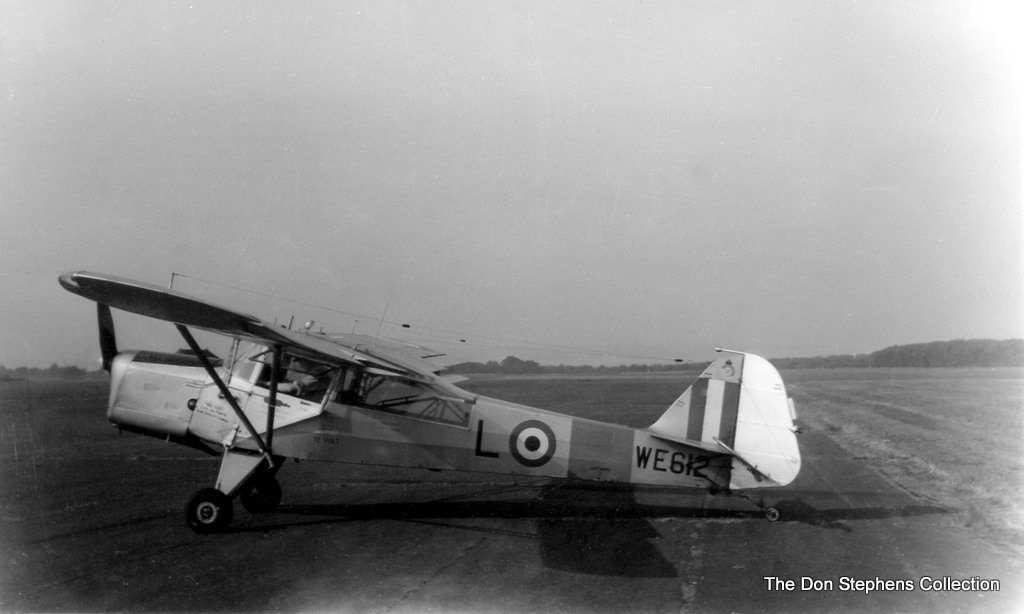
WE612/L an Auster T.7 at Hooton 24th July 1955 – the best of 3 very similar photos in Don’s collection.

VF547/B an Auster AOP.6. While this photo appears in Aldon Ferguson’s ‘Cheshire Airfields of the Second World War’ (Countryside Books, 2008) as a Phil Butler shot taken at Hooton, the exact same photo is indexed by Don Stephens as being taken at
Hawarden Battle of Britain display 15th September 1956. The public address speakers and background tend to suggest that Hawarden is the correct location.
Added late 11.23: The Hawarden location absolutely confirmed by Dave Smith, who identifies the church tower as being that of Broughton Church. I'll leave the photo here, otherwise Dave's post will stand supported, the image already appears on the Hawarden Battle of Britain 1956 post too.
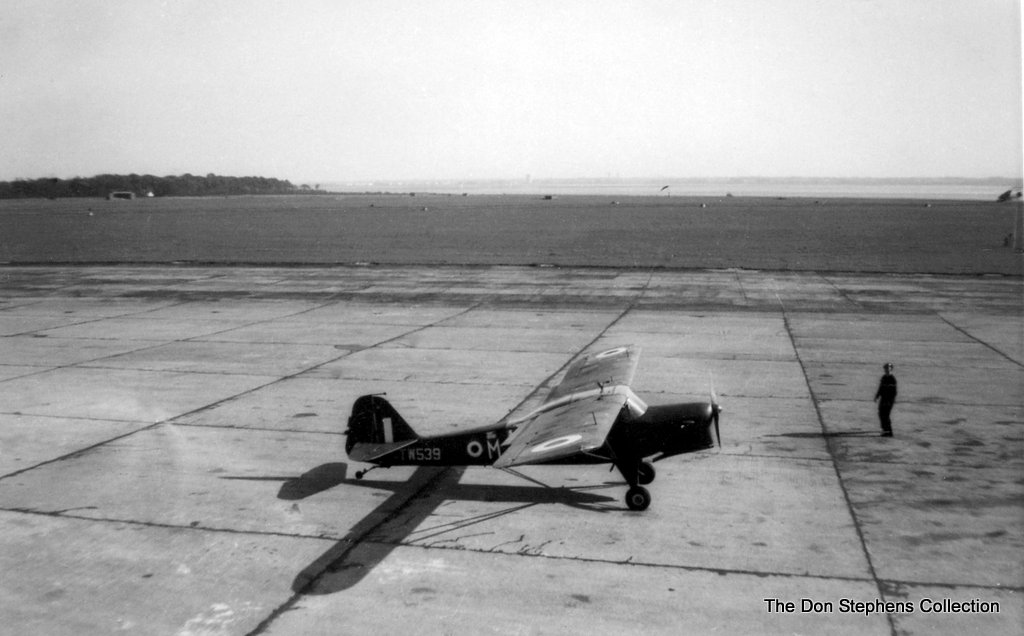
While this shot is quite clearly Speke, looking across the river towards Hooton, this is another of Hooton based, 663 Squadron's Auster AOP.6 aircraft. TW539/M is known to have visited Speke at least once, on 19th September 1954.